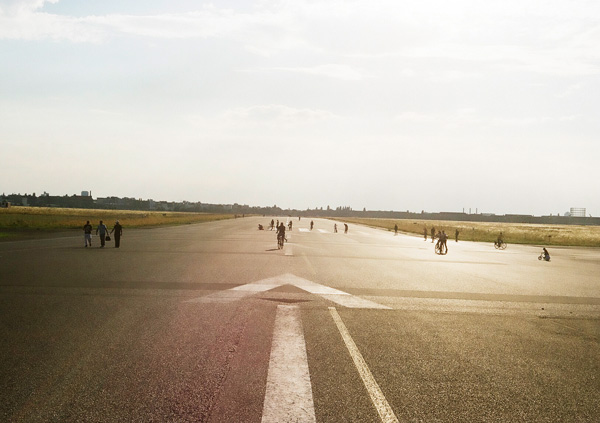 In the current November issue of our favourite Japanese style bible, Huge, you can find our third contribution to the Storyboard column rotating around the globe, with us covering the Berlin frontier, this time on the phenomenon of Tempelhofer Freiheit, which is one of the many reasons we love this city so much.
In the current November issue of our favourite Japanese style bible, Huge, you can find our third contribution to the Storyboard column rotating around the globe, with us covering the Berlin frontier, this time on the phenomenon of Tempelhofer Freiheit, which is one of the many reasons we love this city so much.
Imagine an area larger than New York’s Central Park, or 500 football fields one after another, in the middle of the city. And then imagine it being absolutely flat, and entirely empty, and utterly silent – no buildings, no streets, no cars, no trees. Imagine how nice it would be to be able to see miles ahead of you, imagine how quiet it would be with all the traffic noise far away. Imagine the sky – how the weather would be so much more present, a surprising wind blowing in your hair, the sun shining brighter than you could imagine, the clouds floating deeper than you thought, or, in winter, the snow just infinite. In Berlin, a place like that exists, and it is called Tempelhofer Freiheit.
Tempelhofer Freiheit is the former landing strip of Tempelhof airport, which is an entire story to itself: One of the largest buildings in the world, Tempelhof Airport was built in the 1920s but is better known as of the central military airport of the Nazi regime. After the end of World War II, history was reversed and the airport functioned as a home for the US Air Force. Finally, in the late 1940s, Tempelhof Airport became famous as the main transport hub during the iconic Berlin Airlift when the Western Allied Forces provided the city with supplies after the Soviet Union had closed all overland access to the city for eleven months. Primarily a monument to itself after the fall of the Berlin Wall, the building nodded off into a deep slumber for the last few decades as a sleepy city airport and was finally shut down in 2008, with the city government unsure about what to do with such a vast and unique building and its adjacent fields in the centre of the city.
While the government is still debating on the future of the site (my favourite proposal by an architect was to build a mountain), parts of the airport are being hired for fashion and art fairs or concerts whereas the landing strip in 2010 was simply declared a park and opened to the public. And the public came – unexpectedly, Tempelhof in all its glorious weirdness became by far the most popular public space in Berlin, with up to 30,000 visitors on a sunny day. As so often – and not exactly to the government’s liking either, since plans for opening even small portions of the park for commercial use are met with increasing resistance – Berliners stoically embraced the interim and decided that the airport and its landing field are just fine the way they are: empty.
In a strange way, the park is the great equaliser: families come to barbecue, kids come to skateboard or play football or fly kites, students come to cycle or to read in the sun, old ladies come to walk their dogs or help in little urban gardens, lovers come to hold hands and lie in the grass. The wide nothing, the sky, the silence – a sense of calm and peacefulness descends, as if everything will be okay, and you have space to breathe and to feel and to think. Tempelhofer Freiheit – ‘freedom’ – indeed.
Photography by kvr
